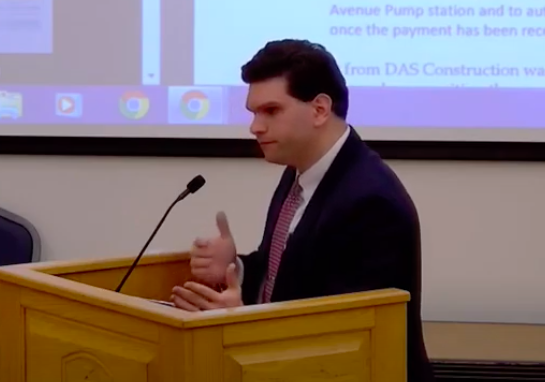NORTH SMITHFIELD – Two upcoming developments in the area of the Belcher Avenue will put the pump station that provides sewer to the surrounding neighborhoods at 95 percent of its capacity, according to information presented this week by the North Smithfield Sewer Commission.
“The problem with that is future western development in this area based on the plan going forward is no longer going to be viable without increasing the size of the Belcher Avenue pump station,” explained commission member Philip Gasbarro.
Approved developments that will put the station near its maximum include the 120-unit Slater Village, and the 66 units proposed as part of Silver Pines, Stage II.
“Should the developer be kicking in for that? Is that something that will have to be paid by rate payers in the future?” Gasbarro asked. “The concern is if all the development that’s in part of the comprehensive plan comes into being, you’re going to have to upgrade this station.”

The warning comes beside an updated Wastewater Facilities Plan that points to the need for $8 million in upgrades and maintenance over the next five years. Gasbarro noted that an upgrade to the pumps and interceptor lines at the Belcher Avenue station alone would cost an additional $750,000 to $1 million.
The process of looking at the sewer plan – last updated in 2007 – began after the Rhode Island Department of Environmental Management flagged Slater Village, a proposed a 7.6-acre complex off Victory Highway, over sewer capacity concerns last August. RIDEM refused to issue a permit for the complex until the town’s waste facilities plan was brought up-to-date, effectively halting the project.
In the months that have followed, members of the Sewer Commission have worked with firm Wright-Pierce to update the town’s five year sewer plan, a roadmap for how North Smithfield intends to maintain and improve the infrastructure.
“There were a lot of small updates needed just to make it consistent with the new 2019 comprehensive plan,” Gasbarro said, noting this week that the new document was ready for Town Council approval. “We’re satisfied that everything has been updated.”
Gasbarro said that through the course of updating the plan, it was determined that the Belcher Avenue station can handle the two upcoming developments, but the town could be limited in the future.
“It’s a little bit of a novel situation we’re finding, just because the capacity is currently there,” he said. “If they put the full project in, the pump is still only operating at 95 percent capacity. It’s not that their project maxes out or exceeds the pump – it just reduces ability for it to handle future development.”
Gasbarro noted that the pump station upgrade was not included in the five-year plan, which mostly addresses keeping up with maintenance and repairs. Having that plan, he noted, doesn’t mean the town needs to start making repairs immediately, but serves as more of a guidebook.
“We’re not obligated to undertake millions of dollars in work,” Gasbarro said.
He noted that the commission hopes to apply for infrastructure funding for the needed work.
“Fingers are crossed that they’re going to be giving out a lot of grant money,” he said. “We might be able to get at least some funding over this multi-year grant program.”
“This is a little bit different,” he added of the Belcher Avenue station.
Town Administrator Paul Zwolenski asked if those behind the housing projects should pitch in for the needed expansion.
“Why not have the developers put in a contribution because they’re coming in and using up all of the capacity?” Zwolenski asked. “Are they going to pay for that? It leaves us nothing for expanding into neighborhoods or doing any infrastructure upgrades.”
Councilor Paul Vadenais pointed out that other new users on the town’s sewer system must pay a connection fee and an assessment. For a single family home to tie in, the cost is currently $5,200.
“If you build a house on a lot that wasn’t there, you tie in, you pay an assessment to tie into that line, and you pay a user fee,” Vadenais said.
“Personally, I think the builder should have a big clump put on his plate,” said Councilor Claire O’Hara of the upgrade. “If he wants to develop an area, he’s going to have to help pay for a necessity: septic and water.”
Gasbarro noted that despite the 95 percent figure, it would take more than a few houses to tie in to put the Belcher Avenue pump station over capacity.
“What the engineers are really flagging for us is the ability to continue with those future development and expansion plans,” he said, pointing to the possibility of 50 or 60 unit complexes.
Town Council President John Beauregard said that having a system near capacity could actually be a positive in term of holding off more large scale developments.
“I don’t think that’s the worst thing in the world,” Beauregard said. “If we’re at capacity and we can’t put up 30 (or) 40-house projects in the town.”
“You bring in water and sewer, and houses start going up,” Beauregard added. “I personally think we should try to do what we can to limit large parcels of land being developed. Maybe this is just what we need, and something like this is perfect.”
Councilors unanimously approved the Wastewater Facilities Plan, which is now expected to be sent back to RIDEM.








We should be at 95% capacity. In the business school production management teaches that factories and facilities should operate at close to maximum capacity to help reduce costs. Operations that have too much idle capacity are costly and inefficient. Secondly any maintenance and expansion costs needs to be paid for by the users of the sewer system and not the taxpayers who have a septic system. I remember one politician in North Smithfield, not to mention anyE names, who wanted all taxpayers to pay for water and sewer maintenance as to lower his burden/impact. This is what happens when you elect unqualified people who’s only concern is keeping town employees happy with raises and less work hours and allocate no funds to annual maintenance. You end up with major expenditures, this is the same issue with the school department.